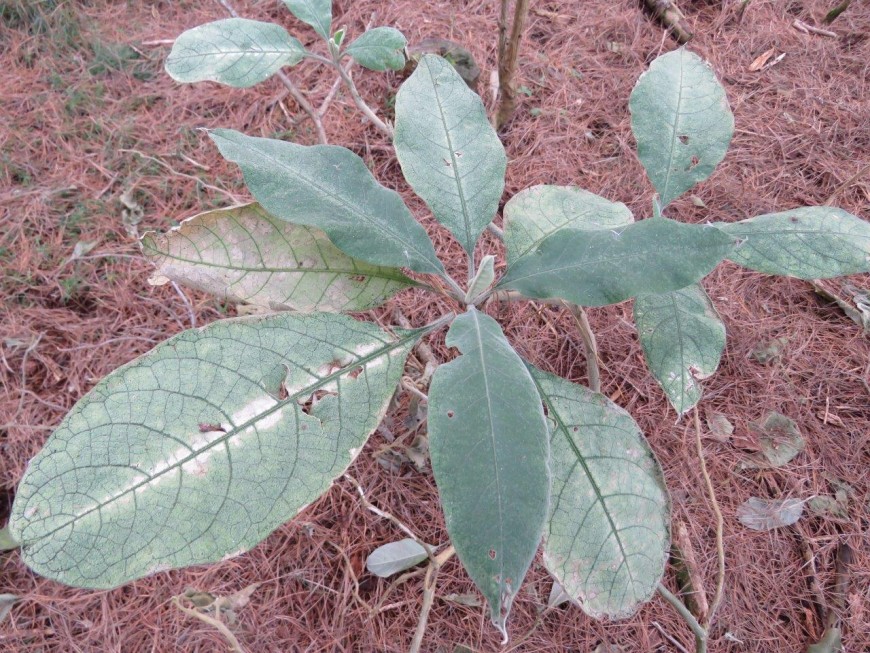Shedding Light on Herbivore Preference
In 2010 a leaf-feeding lace bug, Gargaphia decoris, was introduced to take on this noxious weed. However, the variable impact of the lace bug on woolly nightshade since its release has been a bit of a conundrum. At many localities we struggle to find a single lace bug, yet at some release sites they have prospered. For example, at Ngapeke, in the western Bay of Plenty, woolly nightshade plants have been heavily attacked and defoliated every year, often resulting in plant death.

Image: heavily damaged woolly nightshade tree due to lace bug feeding.
Sites where woolly nightshade lace bugs have flourished have one thing in common: shade. Heavily infested plants are usually found growing in sheltered sites, such as in the understorey and sheltered logging roads of forestry plantations, where the woolly nightshade plants are shaded for much of the day. Plants in full sun are rarely damaged to any great extent – even those growing just outside the forest a short distance from heavily infested shaded plants at Ngapeke.
Why attack is confined to shady sites has been a mystery, Quentin Paynter explained. “We first suspected that predators, or perhaps parasitoids, were more abundant in sunny sites compared to shady sites,” he said. “But we found that predatory insects, such as lacewings, ladybirds, and ants, really weren’t very common when we sampled woolly nightshade plants in the shade or in the sun, and we didn’t rear a single parasitoid from adult lace bugs, their nymphs, or their eggs,” he added.
The potential for birds to feed on the lace bugs was also considered, but there were plenty of fantails at the shady Ngapeke site, so that didn’t seem a likely explanation either.
We really were in the dark until a recent publication by Cecilia (Ceci) Falla and her co-authors shed some light on the issue and provided a compelling explanation. Ceci, who chose the woolly nightshade lace bug as a study organism for her PhD at the School of Agriculture and Environment at Massey University in Palmerston North, tested the effects of low shade and high shade on the physical and chemical traits of woolly nightshade and the performance of the lace bug under glasshouse conditions.
Image: Ceci measuring light intensity.
Ceci found that the leaves of plants under low-shade conditions were smaller, thicker, had longer trichomes (defensive hairs that coat the underside of woolly nightshade leaves), lower water content, and lower specific leaf area compared to high-shade leaves. Leaves of low-shade plants also increased their carbon to nitrogen (C:N) ratio at a faster rate as they aged, and had a higher total glycoalkaloid concentration than high-shade plants.
Nitrogen is a key element for insect development, and if the C:N ratio in their food increases, they get less nitrogen per ‘mouthful’. This can affect growth, survival and development time (which may affect the number of generations per year). Glycoalkaloids are compounds that contribute to the defence response of plants against herbivore attack. “Therefore, one might predict that the leaf chemistry of shaded plants should be more suitable to herbivores, compared to plants growing in full sun,” said Ceci.
Ceci found that woolly nightshade lace bugs initially showed no discrimination between high-shade and low-shade leaves for oviposition or feeding. However, second generation females on the same (now older) plants failed to oviposit on the low-shade plants and displayed smaller bodies compared to the females that developed feeding on the high-shade plants. Ceci and co-authors concluded that light intensity affects both the physical and chemical traits of woolly nightshade plants as the plants age, and these effects influence lace bug performance.
Although the key factor behind the differential performance of the woolly nightshade lace bug under contrasting light conditions remains unclear, the chronic impact suggests that differences in leaf chemistry, rather than physical defences, contribute to the variability of lace bug performance. The ongoing implication of this phenomenon is that additional natural enemies are probably required to fill this gap for the woolly nightshade programme to achieve effective control.
Further Reading
Falla C, Minor M, Harrington K, Paynter Q, Cordiner S, Najar-Roriguez A 2023. Effects of light intensity on Solanum mauritianum (Solanaceae) morphological and chemical traits and the performance of its biological control agent Gargaphia decoris (Hemiptera: Tingidae). Biological Control 181: 105218. https://doi.org/10.1016/j.biocontrol.2023.105218
Contact

